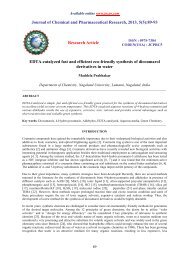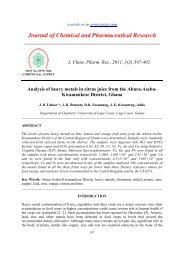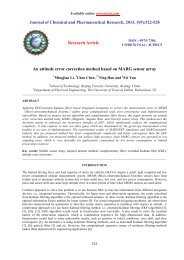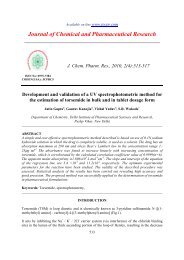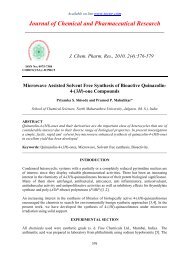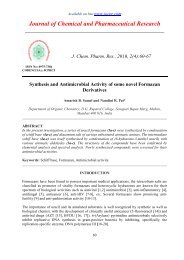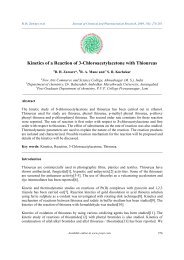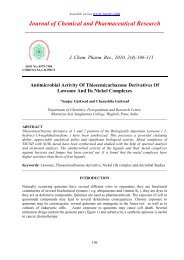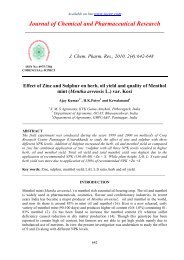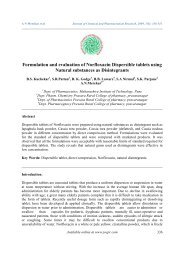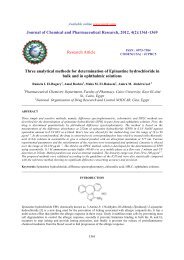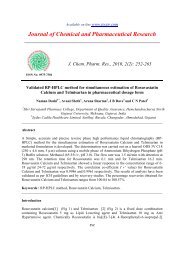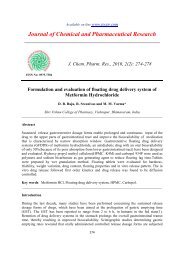The controversial reaction mechanism of Stevens ... - ResearchGate
The controversial reaction mechanism of Stevens ... - ResearchGate
The controversial reaction mechanism of Stevens ... - ResearchGate
Create successful ePaper yourself
Turn your PDF publications into a flip-book with our unique Google optimized e-Paper software.
Soumendranath BhakatJ. Chem. Pharm. Res., 2011, 3(1):115-121______________________________________________________________________________Hill and Chan 8 reported that the alkylbenzylmethyl ammonium cation gave 15 % <strong>of</strong> the normalproduct which is optically active (Figure 3). <strong>The</strong> formation <strong>of</strong> this product can be explained byinvoking either <strong>of</strong> the above two <strong>mechanism</strong>s.Figure 3. <strong>The</strong> illustration <strong>of</strong> <strong>Stevens</strong> Rearrangement by Hill and ChanFigure 4. Formation <strong>of</strong> Normal and Abnormal product in <strong>Stevens</strong> Rearrangement118
Soumendranath Bhakat J. Chem. Pharm. Res., 2011, 3(1):115-121______________________________________________________________________________Evidence has accumulated 9, 10 for the radical pair <strong>mechanism</strong> for explanation <strong>of</strong> <strong>Stevens</strong>Rearrangement. Analogous to Wittig rearrangement and the observation that the <strong>Stevens</strong>rearrangement proceeds via partial retention <strong>of</strong> configuration <strong>of</strong> the migrating group led tosuggest the radical pair <strong>mechanism</strong>. For instance optically active 3 ○ amine (A) rearranged to (B){normal product} with only partial retention <strong>of</strong> stereochemical integrity. Another product (C){abnormal product} was also isolated 11 (Figure 4).Chemically Induced Dynamic Nuclear Polarization 12,13 spectra observed in many cases alsosupported the radical pair <strong>mechanism</strong> which is deplicated below (Figure 5).Figure 5. <strong>The</strong> radical pair <strong>mechanism</strong> <strong>of</strong> <strong>Stevens</strong> Rearrangement<strong>The</strong>oretical Investigation <strong>of</strong> the Reaction Mechanism<strong>The</strong> first theoretical study was performed in 1974 by Dewar et al. 14 , who pointed out that the keystep <strong>of</strong> the rearrangement could be a case <strong>of</strong> breakdown <strong>of</strong> the Woodward- H<strong>of</strong>fmann rulesbecause <strong>of</strong> the high exothermicity <strong>of</strong> the <strong>reaction</strong>. <strong>The</strong> migration would take thus place through a“formally forbidden” concerted tight transition structure with retention <strong>of</strong> configuration. <strong>The</strong>energy barrier, calculated by the semiempirical method MINDO/3, was only 4 kcal mol -1 high.However, the energy <strong>of</strong> the separated radicals was calculated as-10 kcal mol -1 with respect to theylide. <strong>The</strong>refore, the authors concluded that it was not possible to distinguish between the two<strong>mechanism</strong>s (“ionic pair” and “radical pair” <strong>mechanism</strong>s).<strong>The</strong>reafter in 1990s Heard and Yates 15-20studied the <strong>reaction</strong> <strong>mechanism</strong> <strong>of</strong> the <strong>Stevens</strong>Rearrangement extensively via semiempirical (MINDO) and ab initio (HF, MP2, MP4, CCSD)methods. In all cases they concluded that the radical pair <strong>mechanism</strong> by 20-40 kcal/mol. <strong>The</strong>optimized geometries by Heard and Yates are also in good agreement, and the ionic pair<strong>mechanism</strong> was also found to be non-competitive.But the diradical pathway <strong>of</strong> the <strong>Stevens</strong> Rearrangement was not fully investigated by Heard andYates since they always give reference to the separated radicals.Recently Ghigo et al. 21 fully investigated the <strong>mechanism</strong> <strong>of</strong> the <strong>Stevens</strong> Rearrangement onseveral substrates. This study suggests that the <strong>reaction</strong> takes place by a diradical <strong>mechanism</strong>through the hemolytic dissociation <strong>of</strong> the C-N bond in the ylide to form a radical couple. Thisstep follows by radical coupling <strong>of</strong> either retention <strong>of</strong> configuration or the inversion <strong>of</strong>conversion (Figure 6) [TS=Transition state].119
Soumendranath Bhakat J. Chem. Pharm. Res., 2011, 3(1):115-121______________________________________________________________________________Figure 6. TS radical coupling with configuration inversion (left) and configuration retention (right) in the (1-phenylethyl)-dimethyl ammonium ylide 21<strong>The</strong>y also find that there is an exception to the diradical <strong>mechanism</strong> when the migrating group isphenyl; they observed that in that case the migration takes place via a concerted closed-shellpolar transition structure and the <strong>mechanism</strong> is similar to the ionic pair <strong>mechanism</strong>.CONCLUSIONBut neither Heard and Yates nor Ghigo et al. explained the formation <strong>of</strong> the product (C) 11 . Thisis still in doubt that whether the ionic pair <strong>mechanism</strong> or the radical pair <strong>mechanism</strong> which oneprefers in the formation <strong>of</strong> the product (C). Neither <strong>of</strong> them gives the explanation on theformation <strong>of</strong> the coupling product R-R 22-25 . Because <strong>of</strong> these lackings the doubt still continues onthe <strong>mechanism</strong> <strong>of</strong> a typical <strong>Stevens</strong> Rearrangement. But still now as per CIDNP study and sometheoretical investigations the Radical pair <strong>mechanism</strong> has an edge over the Ionic pair <strong>mechanism</strong>in explanation <strong>of</strong> the <strong>reaction</strong> <strong>mechanism</strong> <strong>of</strong> <strong>Stevens</strong> Rearrangement.REFERENCES[1] Pine, S. H. Org. React. 1970, 18.[2] T.S. <strong>Stevens</strong> et al. J. Chem. Soc., 1928, 3193[3] T.S. <strong>Stevens</strong> et al. J. Chem. Soc., 1932, 1926[4] Johnstone, R.A.W., T.S. <strong>Stevens</strong>. J. Chem. Soc. 4487-4488 (1955).[5] Hauser, C.R., S.W. Kantor. J. American Chem. Soc. 73, 1437-1441 (1951).[6] R.B.Woodward and R. H<strong>of</strong>fmann"Conservation <strong>of</strong> Orbital Symmetry Angew. Chem.Internat. Edit. (1969) 8:781-853" doi:10.1002/anie.196907811120
Soumendranath Bhakat J. Chem. Pharm. Res., 2011, 3(1):115-121______________________________________________________________________________[7] Brewster.J.H and Klein.M.W,J. American Chem. Soc.74,5179(1952)[8] Hill .Richard , Chan.T, J. Am. Chem. Soc., 1966, 88 (4), pp 866–867 DOI:10.1021/ja00956a064[9] Schöllkopf, U., U. Ludwig, G. Ostermann, M. Patsch. Tetrahedron Lett. 10, 3415-3418(1969).[10] Baldwin.J.E et al.;Chem. Commun.;576(1970)[11] Zhang, J.J., G.B. Schuster. J. Org. Chem. 53, 716-719 (1988).[12] Lepley.A.R,J.Am.Chem.Soc.,91,1237(1969)[13] Chantapromma, K., M.D. Ollis, I.O. J. Chem. Soc. Perkin I, 1049-1061 (1983).[14] Dewar, M. J. S.; Ramsden, C. A. J. Chem Soc., Perkin Trans. 1 1974,1839–1844[15] Heard, G. L.; Frankcombe, K. E.; Yates, B. F. Aust. J. Chem.1993, 46, 1375–1388.[16] Heard, G. L.; Yates, B. F. Aust. J. Chem. 1994, 47, 1685–1694.[17] Heard, G. L.; Yates, B. F. THEOCHEM 1994, 116, 197–204.[18] Heard, G. L.; Yates, B. F. Aust. J. Chem. 1995, 48, 1413–1423.[19] Heard, G. L.; Yates, B. F. J. Comput. Chem. 1996, 17, 1444–1452.[20] Heard, G. L.; Yates, B. F. J. Org. Chem. 1996, 61, 7276–7284.[21] Ghigo et al., J. Org. Chem. 2010, 75, 3608–3617 DOI: 10.1021/jo100367z[22] Pine, S. H.; Catto, B. A.; Yamagishi, F. G. J. Org. Chem. 1970, 35, 3663–3665.[23] Jemison, R. W.; Morris, D. G. Chem. Commun. 1969, 1226–1227.[24] Lepley, A. R. Chem. Commun. 1969, 1460–1462.[25] Lepley, A. R.; Becker,R. H.; Giumanini, A. G. J. Org. Chem. 1971, 36, 1222–1227.121



